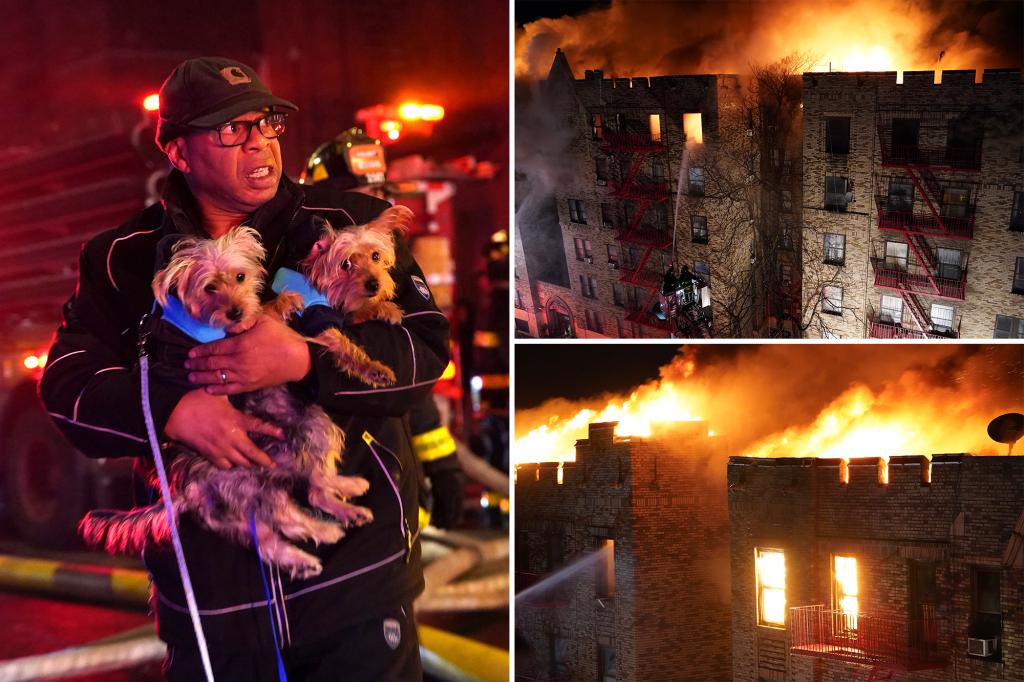The pre-dawn hours of a Friday morning in the Bronx were shattered by a raging inferno that engulfed a six-story residential building at 2910 Wallace Avenue. Close to 200 firefighters from the New York City Fire Department (FDNY) converged on the scene, battling not only the intense flames but also challenging wind conditions that rapidly escalated the blaze to a five-alarm status, the highest level of severity. The fire, which erupted around 1:40 a.m., quickly consumed the structure, sending plumes of thick, black smoke and fiery embers skyward, a scene captured in alarming videos circulating on social media. The intense heat and rapidly spreading flames presented a significant challenge to firefighting efforts, forcing crews to adopt defensive tactics to protect surrounding structures and ensure the safety of residents and responders. Initial reports confirmed at least seven individuals sustained injuries in the incident, including five firefighters who bravely confronted the blaze and two civilians caught in the chaos. While one civilian received on-site treatment and declined further medical attention, the extent of the remaining injuries remains unclear.
The fire’s rapid escalation to a five-alarm status underscores the scale and intensity of the blaze. This classification, the highest on the FDNY’s scale, signifies a major fire requiring substantial resources and manpower. The response involved the deployment of nearly 200 firefighters, numerous fire trucks, specialized equipment, and command units. The significant wind conditions played a critical role in the fire’s rapid spread, fanning the flames and creating unpredictable fire behavior. These conditions posed a substantial risk to firefighters, requiring them to exercise extreme caution and adapt their strategies to the dynamic environment. The presence of strong winds also increased the potential for the fire to spread to adjacent buildings, further intensifying the urgency of the situation and the need for a swift and effective response.
The early morning timing of the fire likely contributed to the challenges faced by both residents and first responders. With many residents asleep, the rapid spread of flames and smoke could have limited escape routes and increased the risk of smoke inhalation. The disorientation and panic that often accompany such events further complicate evacuations, adding to the difficulties faced by firefighters tasked with rescuing trapped individuals and ensuring the safety of all occupants. The limited visibility caused by the thick smoke and the unpredictable nature of the fire fueled by the strong winds created a hazardous environment for firefighters, requiring them to operate with extreme caution and rely on their training and experience to navigate the treacherous conditions.
As the fire raged, the FDNY focused on containing the blaze and preventing its spread to neighboring buildings. The five-alarm status triggered a massive response, bringing in substantial manpower and specialized equipment, including aerial ladders, water towers, and rescue units. Firefighters worked tirelessly, braving the intense heat and smoke, to extinguish the flames and protect surrounding structures. The scale of the fire and the challenging conditions demanded a coordinated and strategic approach, with command officers directing operations and ensuring the safety of all personnel involved. The focus on containment and prevention of further spread likely involved creating firebreaks and deploying significant water resources to cool down adjacent buildings and prevent ignition.
While initial reports indicate seven injuries, the full extent of the damage caused by the fire remains to be assessed. The intense heat and flames would have likely caused significant structural damage to the building, potentially rendering it uninhabitable. The displacement of residents and the loss of personal belongings represent significant human costs in addition to the physical damage to the structure. The investigation into the cause of the fire will be a crucial step in understanding the events that led to this devastating incident and identifying potential preventative measures for the future. Fire investigators will meticulously examine the scene, searching for clues and gathering evidence to determine the origin and cause of the blaze.
The immediate aftermath of the fire presents significant challenges for both the affected residents and the city’s emergency services. Displaced residents will require temporary housing, essential supplies, and emotional support as they grapple with the shock and loss caused by the fire. The city’s resources will be stretched to provide adequate assistance and support to those affected, requiring coordination between various agencies and community organizations. The long-term recovery process will involve addressing the structural damage to the building, providing ongoing support to displaced residents, and conducting a thorough investigation to determine the cause of the fire and prevent similar incidents in the future. The fire serves as a stark reminder of the ever-present dangers of fire and the importance of fire safety measures and preparedness.

